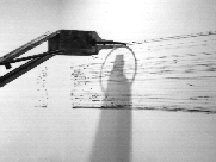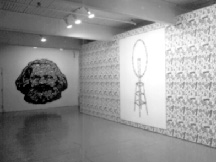- MAIN INDEX | ARTIST INDEX
| June 10 - July 5, 1986 Randy Anderson and Alan Storey Curated by Daina Augaitis | |
 Objecthood: A Dichotomy, Alan Storey, installation view of "Draw", 1986. Photo courtesy of Alan Storey. 18K |  Objecthood: A Dichotomy, Randy Anderson, installation view, 1986. Photo Peter MacCallum. 18K |
| PRESS RELEASE Objecthood: A Dichotomy, an exhibition featuring the work of Vancouver artists Randy Anderson and Alan Storey will open at Mercer Union on June 10 at 8 pm. The exhibition will continue through July 5, 1986. Since Duchamp, artists have been compelled to continue an investigation into the nature of the art object and analyze the degree to which a work of art is inextricably linked to the social structures that surround it. It is the notion of objecthood or materiality that offers a point of comparison for the installations of Randy Anderson and Alan Storey. While both artists are concerned with physicality, they represent two distinct, if not opposite approaches in their forms of presentation and their content. Even amid these otherwise diverse perspectives, there are corresponding themes. Randy Anderson's installations are informed by a strong critical perspective and are involved in revealing ideologies that we take for granted. Choosing everyday consumer objects as his content, he challenges their power by denying them any three-dimensional life. His cool, discomforting work questions issues such as the militaristic bias of our capitalist system and, the commodification of culture. After graduating from Concordia University in 1983 with a BFA, Randy Anderson returned to Vancouver where he studied briefly at Emily Carr College of Art. During the last three years he has exhibited extensively in Vancouver and Victoria and, as well, has participated in group exhibitions in Saskatoon, Seattle, Toronto and Montreal. Alan Storey constructs massive yet delicate structures that are bestowed with human characteristics and are often programmed to perform inane functions. The relatively slight output of these "machines" parodies not only technology and the act of labour, but also skeptically questions the value of artmaking. Alan Storey was born in Summerland, British Columbia in 1960. He received his BFA from the University of Victoria in 1982 and has since participated in numerous group and solo exhibitions in Victoria, Vancouver and Banff. Daina Augaitis, curator of this exhibition, is the newly appointed Assistant Curator at the Walter Phillips Gallery in Banff, following a number of years as curator for Western Front and the Convertible Showroom in Vancouver. In June of 1984, she curated the group exhibition Reconstituted Elements at Mercer Union featuring the work of four west coast sculptors. Recently, Daina Augaitis curated the highly successful group exhibition of video installations, Luminous Sites, held this past spring in Vancouver. Objecthood: A Dichotomy is a collaborative effort between Mercer Union and Open Space Gallery in Victoria, and was first presented at Open Space in May of this year. Alan Storey, Randy Anderson and Daina Augaitis will be present at the opening on Tuesday June 10 at 8 pm.
Carole Corbeil Objecthood: A Dichotomy, an exhibition featuring the work of Vancouver artists Randy Anderson and Alan Storey will open at Mercer Union on June 10 at 8 pm. The exhibition will continue through July 5, 1986. Curated by Daina Augaitis, this exhibition features the work of two Vancouver artists who are "compelled to continue an investigation into the nature of the art object and analyze the degree to which a work of art is inextricably linked to the social structures that surround it." Randy Anderson makes his own wallpaper, which is populated by flat, banal consumer objects like cars, toilets, kettles and televisions. He cuts this wallpaper into various shapes which are then applied to the wall. One wallpaper drawing becomes Karl Marx's face, another frames Marcel Duchamp's bicycle wheel on a stool, and yet another is shaped into his own signature. The stuff looks great, but it does I not say much that has not been said before. Yes, Marx could not have anticipated the resilience of capitalism once it moved into mass production of commodities; yes, Duchamp's response to such a situation has itself been appropriated by the very forces it was mocking; and yes, an art signature is now the object par excellence. Alan Storey takes an entirely different approach, and his massive construction, entitled Draw, is a curious embodiment of the post industrial state. It is composed of huge beams which pivot around the room. At the end of the beam which extends toward the wall, a bicycle wheel has been attached. The wheel is moistened by an ink pad, and as the beam is pushed around the room, it draws on the wall. The contrast between the elaborate and massive structure, and the delicate and somewhat ridiculous task it is performing, feels apt, somehow. It captures what is concealed in the armature of the technological state: the materials used and depleted are in many cases out of proportion to the grain.
Christopher Hume Drawing Conclusions: Until fairly recently, nature has been the main preoccupation of west coast artists. Considering the beauty of British Columbia, that's hardly surprising. But as the installations by Vancouverites Alan Storey and Randy Anderson at Mercer Union (333 Adelaide St. W.) demonstrate, that's all changing now. For particular interest is Storey's Draw. This large, lugubrious structure has been designed to be absolutely useless. It consists of several huge wooden beams with a bicycle wheel attached. As it revolves around a specifically constructed room, it leaves lines of ink on the walls. Watching this clumsy yet carefully programmed contraption, we are reminded that a great deal of human activity--especially art making--is meaningless. The irony is that by having gone to the trouble necessary to make this piece, Story denies the very meaninglessness he intends to illustrate. This is one instance where the medium is not the message. For Anderson, art is a means of examining conflicting ideologies. He portrays Karl Marx, for example, using wallpaper illustrated with consumer goods such as TVs, toilets, telephones and electric kettles. In another piece he reproduces his signature three feet high in the same material. It is Anderson's comment on the "commodifiction" of art and the artist. All that is needed to complete the statement is for someone to buy the piece and hang it above the living-room couch.
| |